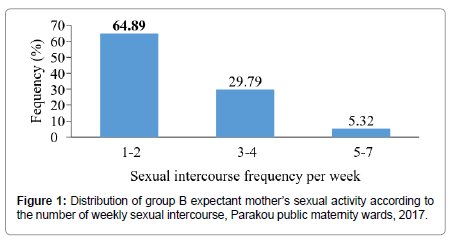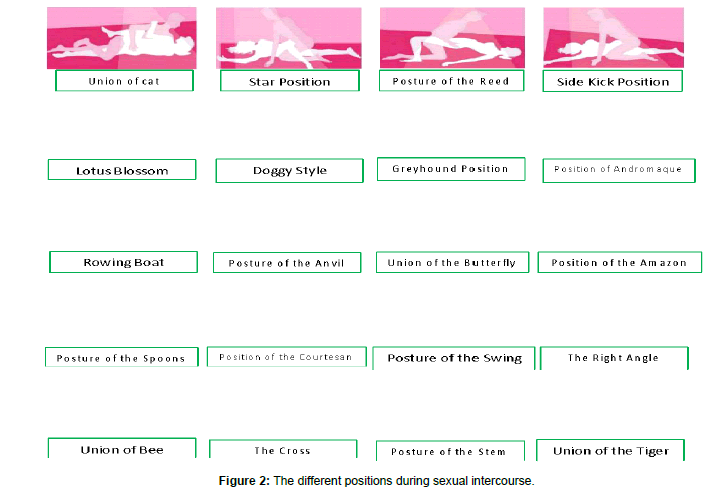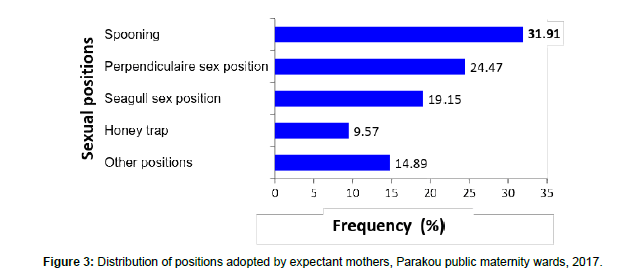Impact of Sexuality on Full Term Expectant Mothers Labor Induction in Parakou
Received: 14-Nov-2017 / Accepted Date: 22-Dec-2017 / Published Date: 29-Dec-2017 DOI: 10.4172/2376-127X.1000361
Abstract
Introduction: The expectant mother’s natural body changes will lead the couple to redefine their emotional and sexual life throughout pregnancy.
Objective: Study the influence of sexuality on full term expectant mothers’ labor induction in Parakou.
Methods: It was a cross-sectional, descriptive and analytical study conducted from 15th April to 15th August 2017 in Parakou public maternity wards. Prospective data collection was carried out, along with a comprehensive census of full term expectant mothers with no fetal anomaly incompatible with life and able to deliver vaginally.
Outcomes: Globally, 141 expectant mothers were enrolled in the study, including 47 practicing sexual abstinence (group A) and 94 sexually active (group B). The frequency of weekly sexual activities ranged from 1 to 7 with 2.4 ± 1.5 as mean value. According to group B expectant mothers practicing intra-vaginal ejaculation, sexual intercourse would facilitate delivery (80.00%, p=0.0006). Group B expectant mothers (87, 92.55%) engaged in sexual fondling, including 82 (94.25%) who practiced nipple stimulation. 23 (28.75%) regularly reached orgasm. Nipple stimulation and orgasm influenced significantly spontaneous labor with p=0.0001 and 0.0006 respectively. Among Group A expectant mothers, there were 9 or 19.15% prolonged pregnancy against 0% for Group B, 15 or 31.91% spontaneous delivery against 05.32% for Group B and 9 or 19.15% cesarean section against 4.25% for group B. There is a statistically significant link between sexuality and the mode of delivery (p=0.0001).
Conclusion: Nipple stimulation and orgasm during full term pregnancy facilitate spontaneous labor in childbirth process.
Keywords: Sexuality; Induction; Delivery; Parakou
Introduction
The couple experiences a significant and complex change during pregnancy, both physiologically and psychologically affecting their married life in three ways: Sexuality, sensuality and intimacy [1]. The expectant mother’s natural body changes will lead the couple to redefine their emotional and sexual life throughout pregnancy [2]. Labor induction is spontaneous in some women while it is deliberately initiated among others. Does sexual intercourse facilitate spontaneous labor?We will be able to provide response to this question through this study.
Materials and Methods
It was an analytical descriptive cohort study conducted from 15th April to 15th August 2017 in public maternity wards of the city of Parakou in Benin. Prospective data collection was carried out, along with a comprehensive census of full term expectant mothers with no fetal anomaly incompatible with life and able to deliver vaginally. The comprehensive census is split into two groups of full term expectant mothers, one group A expectant mother (practicing sexual abstinence) for two group B expectant mothers (sexually active). To make the two groups comparable, the choices were based on the same age, same gravidity and parity. Thus, each Group B expectant mother of the same age range (5 years), with the same gravidity and same parity was seen before and after Group A expectant mother. High-risk pregnancies were non-inclusion criteria. The respondents excluded from the study were expectant mothers consulted at term, who had no idea of their last menstrual period (LMP) or those who did not perform any dating scan, the lost to follow-up and expectant mothers who declined giving their informed consent. The variables examined included socio-demographic characteristics, gynecological and obstetric history, sexuality-related characteristics and the outcome of pregnancy. Data were processed with Epi-Info version 3.5.1. Chi2 test and Fisher test were used according to the case based on the sample size obtained. The conventional threshold level of statistical significance was defined by p
Results
Globally, 141 expectant mothers were enrolled in the study, including 47 in group A and 94 in group B.
The patients’ mean age was 26.3 ± 5.2 years with extreme values of 17 and 40. Group A recorded 25.9 ± 5.8 years with extreme values of 18 and 40 years and group B 26.0 ± 6.1 years with extreme values of 17 and 40 years. Table 1 highlights the distribution of patients according to age (Table 1).
| Group A | Group B | Total | P | |||
|---|---|---|---|---|---|---|
| N | % | n | % | |||
| Age range (years) | 0.4819 | |||||
| 15-19 | 8 | 61.54 | 5 | 38.46 | 13 | |
| 20-24 | 11 | 26.83 | 30 | 73.17 | 41 | |
| 25-29 | 16 | 30.77 | 36 | 69.23 | 52 | |
| 30-34 | 6 | 27.27 | 16 | 72.73 | 22 | |
| 35-40 | 6 | 46.15 | 7 | 53.85 | 13 | |
| Total | 47 | 33.33 | 94 | 66.67 | 141 | |
Table 1: Distribution of expectant mothers according to age, Parakou public maternity wards, 2017.
The patients were bigravida and biparous in 47.52% and 32.62% cases respectively (Table 2).
| Group A | Group B | Total | P | |||
|---|---|---|---|---|---|---|
| N | % | n | % | |||
| Gravidity | 0.1961 | |||||
| Primigravida | 13 | 44.83 | 16 | 55.17 | 29 | |
| Bigravida | 17 | 25.37 | 50 | 74.63 | 67 | |
| Multigravida | 13 | 35.14 | 24 | 64.86 | 37 | |
| Grand multigravida | 4 | 50.00 | 4 | 50.00 | 8 | |
| Total | 47 | 33.33 | 94 | 66.67 | 141 | |
| Parity | 0.2074 | |||||
| Nulliparous | 17 | 45.95 | 20 | 54.05 | 37 | |
| Primiparous | 15 | 32,61 | 31 | 67.39 | 46 | |
| Biparous | 10 | 21.74 | 36 | 78.26 | 46 | |
| Multiparous | 4 | 40.00 | 6 | 60.00 | 10 | |
| Grand multiparous | 1 | 50.00 | 1 | 50.00 | 2 | |
| Total | 47 | 33.33 | 94 | 66.67 | 141 | |
Table 2: Distribution of expectant mothers according to gynecological and obstetric history, Parakou public maternity wards, 2017.
The number of weekly sexual intercourse ranged from 1 to 7 with 2.4 ± 1.5 as mean value. The expectant mothers who had sex once or twice weekly represented 64.89%. Varied positions were adopted during sexual intercourse and the most common was spooning (Figures 1-3).
Nipple stimulation facilitated spontaneous labor in 98.78% of cases with statistically significant relationship (RR=1, 3 (0, 9-1, 8), p=0.0001) as well as orgasm (98.00%) with statistically significant influence (RR=1, 3 (1, 0-1, 7), p=0,0006).
Abstinence from sex at final stage of pregnancy increased significantly the frequency of overdue pregnancies, spontaneous childbirth and caesarian sections (p=0.0001) as shown in Table 3.
| Group A | Group B | Total | OR (ICOR) | P | ||||
|---|---|---|---|---|---|---|---|---|
| N | % | N | % | |||||
| Term of delivery | 0.0001 | |||||||
| Full term | 32 | 68.09 | 87 | 92,55 | 119 | |||
| Extension | 6 | 12.77 | 7 | 07.45 | 13 | |||
| Overdue | 9 | 19.15 | 0 | 0.00 | 9 | |||
| Total | 47 | 100.00 | 94 | 100.00 | 141 | |||
| Type of initiation | 3.5 (1, 5-8, 4) | 0.0001 | ||||||
| Spontaneous | 32 | 68,09 | 90 | 95,75 | 122 | |||
| Induced | 15 | 31.91 | 4 | 04.25 | 19 | |||
| Total | 47 | 100.00 | 94 | 100.00 | 141 | |||
| Type of birth | 2.9 (1, 4-6, 3) | 0.0001 | ||||||
| Natural | 32 | 68.09 | 89 | 94.68 | 121 | |||
| Spontaneous | 15 | 31.91 | 5 | 05.32 | 20 | |||
| Total | 47 | 100.00 | 94 | 100.00 | 141 | |||
| Mode of delivery | 2.3 (1, 0-5, 2) | 0.0101 | ||||||
| Vaginal | 38 | 80.85 | 90 | 95.75 | 128 | |||
| Cesarean section | 9 | 19.15 | 4 | 04.25 | 13 | |||
| Total | 47 | 100.00 | 94 | 100.00 | 141 | |||
Table 3: Distribution of expectant mothers according to pregnancy outcome, Parakou public maternity wards, 2017.
Discussion
The mean age of group A expectant mothers was 25.9 years ± 5.8 years against 26 years ± 6.1 for group B population. This finding is similar to Atrian et al.’s records in Iran with 26.38 years ± 6.04 years and 25.61 years ± 4.54 years, respectively [3]. Therefore, the expectant mothers are relatively young. A Malaysian study carried out in 2007 found 29.8 years ± 4.6 years and 29 years ± 4.4 years, respectively, which is higher than ours [4]. The fact that our study was conducted in a single hospital could account for this gap, since not all age ranges were necessarily enrolled.
The number of weekly sexual intercourses in our series ranged from 1 to 7 with 2.4 ± 1.5 as mean value. The expectant mothers who engaged in sexual intercourse once or twice weekly represented 64.89%. A Pakistani survey reported an average frequency of 1.6 sexual intercourses weekly [5]. This figure which is lower than ours could be due to the methodology implemented and the perception about sexuality during pregnancy. In fact, in our study, the expectant mothers who wished to engage in sexual intercourse were given counseling about the possibility to have sex several times a week. As regards the Pakistani survey, it was a KAP (Knowledge Attitude and Practice) study on the expectant mothers’ sexuality during their pregnancy. Thus, each expectant mother completed the survey form according to the usual frequency, without any other prior clarification on sexuality during pregnancy. More so, this frequency lower than ours could be linked to the fact that the expectant mothers were apprehensive and reluctant about sexual intercourse during pregnancy. However, Andi et al. in Malaysia reported an average frequency of 4 sexual intercourses weekly [6]. This frequency higher than ours, could be explained by the fact that in the Malaysian study all expectant mothers engaged in sexual intercourse after interview. They were futher requested to keep a personalized record card in order to facilitate their childbirth.
Out of the 94 sexually active expectant mothers, 87 (92.55%) declared to have engaged in preliminary foreplay (caress) before sexual intercourse. Among the 87 expectant mothers who caressed before sexual intercourse, 82 (94.25%) practiced nipple stimulation. This latter influenced significantly spontaneous labor (p=0.0001). Solomon et al. in Singapore made the same observation, their study targeted two groups of full term expectant mothers, outside of sexual intercourse [7]. One practiced nipple stimulation and the other does not. After three days, 36% of the expectant mothers engaged in nipple stimulation experienced spontaneous labor against 0% among those who did not. Adewolé et al. in Nigeria, who conducted a study similar to that of Solomon, drew the same conclusion: 33% of expectant mothers who practiced nipple stimulation experienced spontaneous labor against 4% of expectant mothers who did not after three days [8].
Within the 94 expectant mothers practicing preliminary foreplay prior to sexual intercourse, 80 or 85.11% declared to have often reached orgasm during sexual intercourse. And among the latter, 98% experienced spontaneous labor. Orgasm influenced significantly spontaneous labor (p=0.0006). However, in a study conducted in Malaysia in 2009, 41.63% of expectant mothers declared to have reached orgasm. Among them, 49.4% experienced spontaneous labor. Nonetheless, there was no statistically significant relationship between reaching orgasm and spontaneous labor (P=0.330) [9]. This gap could be due to the fact that the author did not insist on the importance of orgasm in his study, since he did not provide the expectant mothers with the same levels of information.
Abstinence from sexual intercourse increased significantly the frequency of prolonged pregnancy, spontaneous labor and cesarean section (p=0.0001). Several studies reported this fact. In Iran, Atrian et al. [3] concluded that when full term expectant mothers engaged in sexuality during low-risk pregnancies, it prevented progress towards cases of prolonged pregnancies, in Malaysia, Tan et al. [4] studied the relationship between sexual activity and patients going into labor from 37 weeks of gestation to full term and she concluded a decrease in the development towards prolonged pregnancies in 72% of cases. The expectant mothers practicing sexual intercourse during pregnancy were less likely to experience prolonged pregnancies, spontaneous labor and cesarean section.
Limitations of Study
It wasn’t possible to monitor the expectant mothers so as to ensure their compliance with the agreed sexual intercourse recommendations. More so, there was no parameter to control the level of compliance.
There is need for further studies in view of assessing the dose of prostaglandin and the total quantity of semen required for spontaneous labor.
Conclusion
It is possible for expectant mothers to have sexual intercourse. Nipple stimulation and orgasm during sex on full term pregnancy facilitates spontaneous labor. Therefore, sexuality can be recommended to full term expectant mothers with no contraindication to vaginal delivery.
Acknowledgement
We are grateful to the women and their spouses who have agreed to participate in this study.
References
- De-Montigny PF, Gauthier PDM, Dennie-Fillion E (2015) Sexualité et grossesse L’expérience des couples. Québec: 40-43.
- Decollogny C, Morgantini L, Sapino L (2013) Impact des relations sexuelles sur la modification cervicale et la mise en travail de l’accouchement au terme d’une grossesse à bas risque.
- Atrian MK, Sadat Z, Bidgoly MR, Abbaszadeh F, Jafarabadi MA (2015) The association of sexual intercourse during pregnancy with labor onset. Iran Red Crescent Med J 17: 1-5.
- Tan PC, Yow CM, Omar SZ (2007) Effect of coital activity on onset of labor in women scheduled for labor induction. Obstet Gynecol 110: 820-826.
- Naim M, Bhutto E (2000) Sexuality during pregnancy in Pakistani women. JPMA 50: 1-9.
- Tan PC, Andi A, Azmi N, Noraihan MN (2006) Effect of coitus at term on length of gestation, induction of labor and mode of delivery. Obstet Gynecol 108: 134-140.
- Salmon YM, Kee WH, Tan SL, Jen SW (1986) Cervical ripening by breast stimulation. Obstet Gynecol 67: 21-24.
- Adewole IF, Franklin O, Matiluko AA (1993) Cervical ripening and induction of labour by breast stimulation. Afr J Med Med Sci 22: 81-86.
- Tan, PC, Yow CM, Omar SZ (2009) Coitus and orgasm at term: Effect on spontaneous labor and pregnancy outcome. Singapore Med J 50: 1062-1067.
Citation: Hounkponou FNM, Ahouingnan AY, Kiki O, Kikala FGMY, Gbevo S, et al. (2017) Impact of Sexuality on Full Term Expectant Mothers Labor Induction in Parakou. J Preg Child Health 4: 361. DOI: 10.4172/2376-127X.1000361
Copyright: ©2017 Hounkponou FNM, et al. This is an open-access article distributed under the terms of the Creative Commons Attribution License, which permits unrestricted use, distribution, and reproduction in any medium, provided the original author and source are credited.
Select your language of interest to view the total content in your interested language
Share This Article
Recommended Journals
Open Access Journals
Article Tools
Article Usage
- Total views: 6544
- [From(publication date): 0-2017 - Nov 07, 2025]
- Breakdown by view type
- HTML page views: 5480
- PDF downloads: 1064



